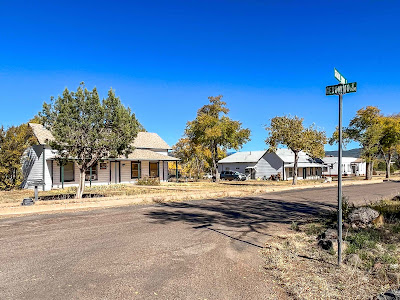About an hour south of Show Low and five miles west of Fort Apache Historic Park in northern Arizona, an unpaved dirt road leads to Kinishba Ruins. It’s a small site that once was home to Ancestral Pueblo people.
 |
| Entrance to Kinishba Ruins |
The entrance fee to Fort Apache includes admittance to Kinishba. At the Nohwiké Bágowa Museum, you can buy a small guidebook about the site. I highly recommend purchasing it because there is no description at Kinishba of what you’re looking at. But there are numbered posts that correspond to explanations in the guidebook about the buildings and spaces at the Kinishba; without the guidebook, I wouldn’t have known what I was looking at.
 |
| One of the buildings at Kinishba |
Occupied from sometime in the 9th century to a time period in the 15th century, the ruins consist of several buildings of dry stone construction. Some buildings still have walls but others just show foundations that are a few feet high. There are also a couple of plazas – small, squarish sections of land but it wasn’t obvious what those spaces were until I read about them in the guidebook.
At its height in the 14th century, as many as 800 people might have inhabited Kinishba. The ruins are situated on a windswept plain, high above a river that ran along the edge of the settlement. Kinishba was an agricultural village and evidence of pottery, jewelry, and artifacts have been found there.
 |
| View to the west of the river down below and mountains on the other side |
In the 1930s, an archaeologist named Byron Cummings supervised the excavation of Kinishba by his students from the University of Arizona and members of the White Mountain Apache Tribe. Cummings also constructed some buildings near the ruins; one served as a museum but it closed in 1952. These buildings are now in a state of disrepair.
 |
| Buildings built by UofA Dean Cummings to simulate the actual Kinishba ruins |
When I visited last November, for most of the time I was the only person at Kinishba. Two other people arrived at one point but they didn’t stay long, perhaps because they didn’t have the guidebook to tell them about the place.
 |
| View of interior of one of the buildings at Kinishba |
I tried to imagine living there a thousand years ago but had a hard time visualizing what it must have been like when Kinishba was a vibrant community filled with people. However, it is well worth the time to seek it out and I very much enjoyed the hour I spent at Kinishba.









